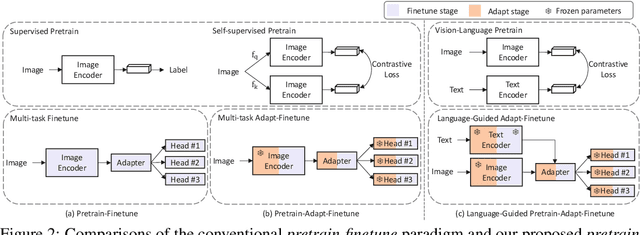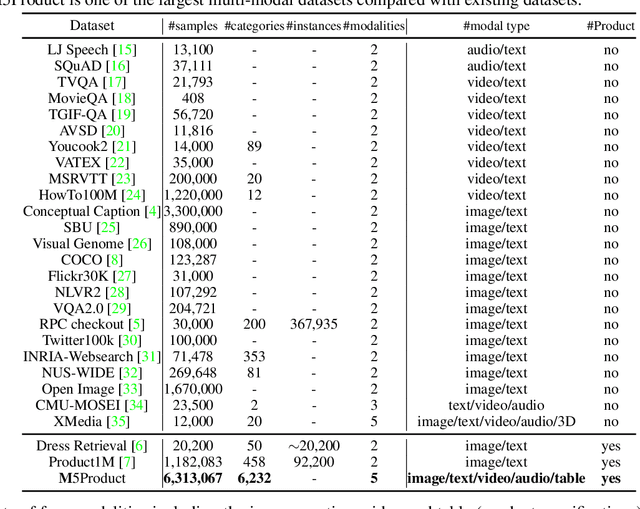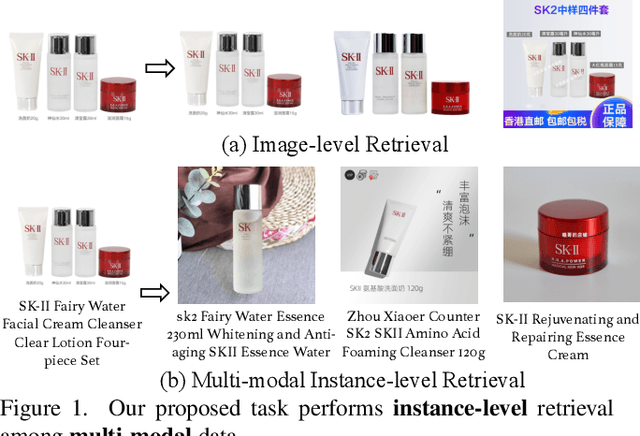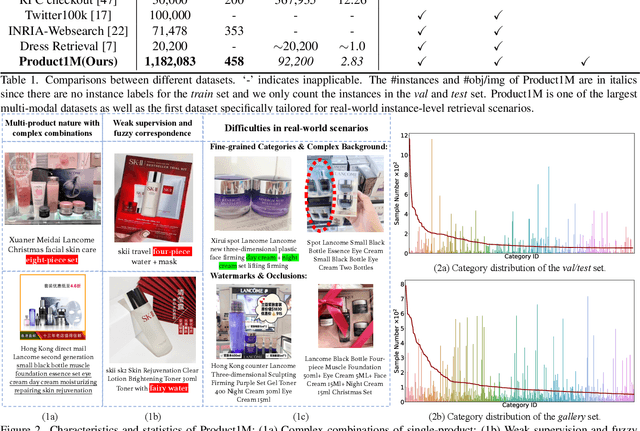Yangxin Wu
Effective Adaptation in Multi-Task Co-Training for Unified Autonomous Driving
Sep 19, 2022



Abstract:Aiming towards a holistic understanding of multiple downstream tasks simultaneously, there is a need for extracting features with better transferability. Though many latest self-supervised pre-training methods have achieved impressive performance on various vision tasks under the prevailing pretrain-finetune paradigm, their generalization capacity to multi-task learning scenarios is yet to be explored. In this paper, we extensively investigate the transfer performance of various types of self-supervised methods, e.g., MoCo and SimCLR, on three downstream tasks, including semantic segmentation, drivable area segmentation, and traffic object detection, on the large-scale driving dataset BDD100K. We surprisingly find that their performances are sub-optimal or even lag far behind the single-task baseline, which may be due to the distinctions of training objectives and architectural design lied in the pretrain-finetune paradigm. To overcome this dilemma as well as avoid redesigning the resource-intensive pre-training stage, we propose a simple yet effective pretrain-adapt-finetune paradigm for general multi-task training, where the off-the-shelf pretrained models can be effectively adapted without increasing the training overhead. During the adapt stage, we utilize learnable multi-scale adapters to dynamically adjust the pretrained model weights supervised by multi-task objectives while leaving the pretrained knowledge untouched. Furthermore, we regard the vision-language pre-training model CLIP as a strong complement to the pretrain-adapt-finetune paradigm and propose a novel adapter named LV-Adapter, which incorporates language priors in the multi-task model via task-specific prompting and alignment between visual and textual features.
M5Product: A Multi-modal Pretraining Benchmark for E-commercial Product Downstream Tasks
Sep 09, 2021



Abstract:In this paper, we aim to advance the research of multi-modal pre-training on E-commerce and subsequently contribute a large-scale dataset, named M5Product, which consists of over 6 million multimodal pairs, covering more than 6,000 categories and 5,000 attributes. Generally, existing multi-modal datasets are either limited in scale or modality diversity. Differently, our M5Product is featured from the following aspects. First, the M5Product dataset is 500 times larger than the public multimodal dataset with the same number of modalities and nearly twice larger compared with the largest available text-image cross-modal dataset. Second, the dataset contains rich information of multiple modalities including image, text, table, video and audio, in which each modality can capture different views of semantic information (e.g. category, attributes, affordance, brand, preference) and complements the other. Third, to better accommodate with real-world problems, a few portion of M5Product contains incomplete modality pairs and noises while having the long-tailed distribution, which aligns well with real-world scenarios. Finally, we provide a baseline model M5-MMT that makes the first attempt to integrate the different modality configuration into an unified model for feature fusion to address the great challenge for semantic alignment. We also evaluate various multi-model pre-training state-of-the-arts for benchmarking their capabilities in learning from unlabeled data under the different number of modalities on the M5Product dataset. We conduct extensive experiments on four downstream tasks and provide some interesting findings on these modalities. Our dataset and related code are available at https://xiaodongsuper.github.io/M5Product_dataset.
Product1M: Towards Weakly Supervised Instance-Level Product Retrieval via Cross-modal Pretraining
Aug 09, 2021



Abstract:Nowadays, customer's demands for E-commerce are more diversified, which introduces more complications to the product retrieval industry. Previous methods are either subject to single-modal input or perform supervised image-level product retrieval, thus fail to accommodate real-life scenarios where enormous weakly annotated multi-modal data are present. In this paper, we investigate a more realistic setting that aims to perform weakly-supervised multi-modal instance-level product retrieval among fine-grained product categories. To promote the study of this challenging task, we contribute Product1M, one of the largest multi-modal cosmetic datasets for real-world instance-level retrieval. Notably, Product1M contains over 1 million image-caption pairs and consists of two sample types, i.e., single-product and multi-product samples, which encompass a wide variety of cosmetics brands. In addition to the great diversity, Product1M enjoys several appealing characteristics including fine-grained categories, complex combinations, and fuzzy correspondence that well mimic the real-world scenes. Moreover, we propose a novel model named Cross-modal contrAstive Product Transformer for instance-level prodUct REtrieval (CAPTURE), that excels in capturing the potential synergy between multi-modal inputs via a hybrid-stream transformer in a self-supervised manner.CAPTURE generates discriminative instance features via masked multi-modal learning as well as cross-modal contrastive pretraining and it outperforms several SOTA cross-modal baselines. Extensive ablation studies well demonstrate the effectiveness and the generalization capacity of our model. Dataset and codes are available at https: //github.com/zhanxlin/Product1M.
Auto-Panoptic: Cooperative Multi-Component Architecture Search for Panoptic Segmentation
Oct 30, 2020



Abstract:Panoptic segmentation is posed as a new popular test-bed for the state-of-the-art holistic scene understanding methods with the requirement of simultaneously segmenting both foreground things and background stuff. The state-of-the-art panoptic segmentation network exhibits high structural complexity in different network components, i.e. backbone, proposal-based foreground branch, segmentation-based background branch, and feature fusion module across branches, which heavily relies on expert knowledge and tedious trials. In this work, we propose an efficient, cooperative and highly automated framework to simultaneously search for all main components including backbone, segmentation branches, and feature fusion module in a unified panoptic segmentation pipeline based on the prevailing one-shot Network Architecture Search (NAS) paradigm. Notably, we extend the common single-task NAS into the multi-component scenario by taking the advantage of the newly proposed intra-modular search space and problem-oriented inter-modular search space, which helps us to obtain an optimal network architecture that not only performs well in both instance segmentation and semantic segmentation tasks but also be aware of the reciprocal relations between foreground things and background stuff classes. To relieve the vast computation burden incurred by applying NAS to complicated network architectures, we present a novel path-priority greedy search policy to find a robust, transferrable architecture with significantly reduced searching overhead. Our searched architecture, namely Auto-Panoptic, achieves the new state-of-the-art on the challenging COCO and ADE20K benchmarks. Moreover, extensive experiments are conducted to demonstrate the effectiveness of path-priority policy and transferability of Auto-Panoptic across different datasets. Codes and models are available at: https://github.com/Jacobew/AutoPanoptic.
Bidirectional Graph Reasoning Network for Panoptic Segmentation
Apr 14, 2020



Abstract:Recent researches on panoptic segmentation resort to a single end-to-end network to combine the tasks of instance segmentation and semantic segmentation. However, prior models only unified the two related tasks at the architectural level via a multi-branch scheme or revealed the underlying correlation between them by unidirectional feature fusion, which disregards the explicit semantic and co-occurrence relations among objects and background. Inspired by the fact that context information is critical to recognize and localize the objects, and inclusive object details are significant to parse the background scene, we thus investigate on explicitly modeling the correlations between object and background to achieve a holistic understanding of an image in the panoptic segmentation task. We introduce a Bidirectional Graph Reasoning Network (BGRNet), which incorporates graph structure into the conventional panoptic segmentation network to mine the intra-modular and intermodular relations within and between foreground things and background stuff classes. In particular, BGRNet first constructs image-specific graphs in both instance and semantic segmentation branches that enable flexible reasoning at the proposal level and class level, respectively. To establish the correlations between separate branches and fully leverage the complementary relations between things and stuff, we propose a Bidirectional Graph Connection Module to diffuse information across branches in a learnable fashion. Experimental results demonstrate the superiority of our BGRNet that achieves the new state-of-the-art performance on challenging COCO and ADE20K panoptic segmentation benchmarks.
 Add to Chrome
Add to Chrome Add to Firefox
Add to Firefox Add to Edge
Add to Edge